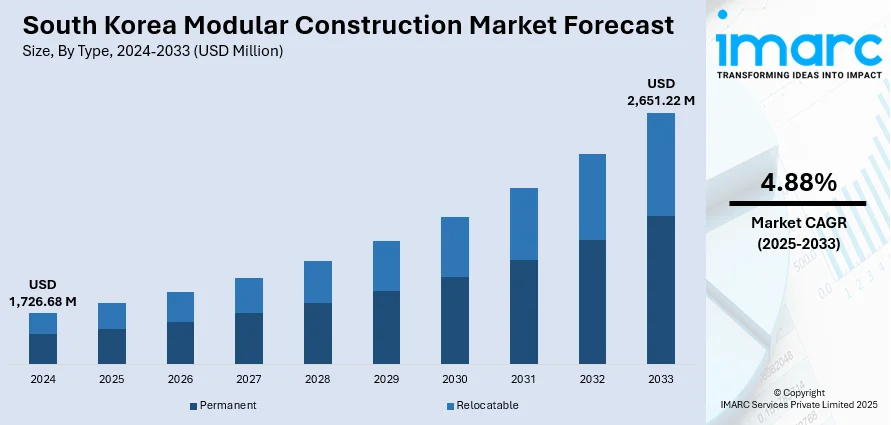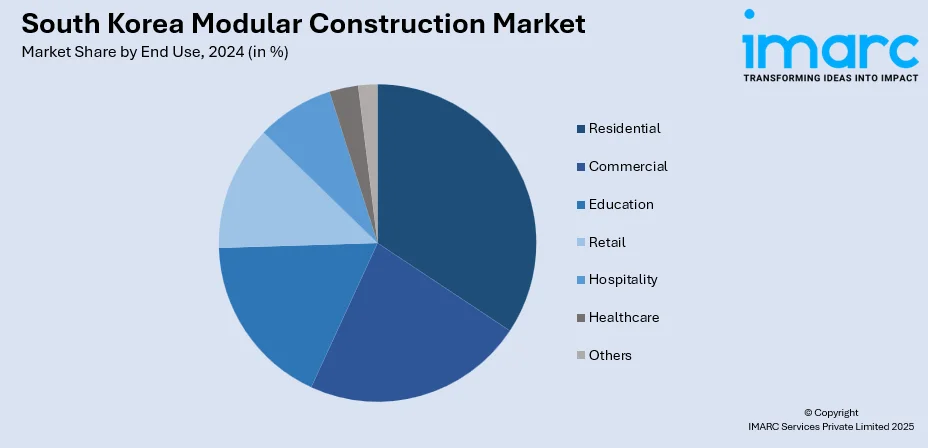
South Korea Modular Construction Market Size, Share, Trends and Forecast by Type, Module Type, Material, End Use, and Region, 2025-2033
South Korea Modular Construction Market Overview:
The South Korea modular construction market size reached USD 1,726.68 Million in 2024. Looking forward, the market is expected to reach USD 2,651.22 Million by 2033, exhibiting a growth rate (CAGR) of 4.88% during 2025-2033. The market is gaining traction as off-site, factory-built modules are increasingly adopted to accelerate building timelines, improve quality, and reduce waste. Major contractors are also leveraging this method for residential and infrastructure projects while expanding overseas due to high domestic costs. Industry growth is further supported by automation, robotics, and government promotion of standardized construction, thus shaping the South Korea modular construction market share.
|
Report Attribute
|
Key Statistics
|
|---|---|
|
Base Year
|
2024
|
|
Forecast Years
|
2025-2033
|
|
Historical Years
|
2019-2024
|
| Market Size in 2024 | USD 1,726.68 Million |
| Market Forecast in 2033 | USD 2,651.22 Million |
| Market Growth Rate 2025-2033 | 4.88% |
South Korea Modular Construction Market Trends:
Urbanization & Affordable Housing Demand
Rapid urbanization in South Korea, especially in densely populated cities, is increasing demand for quick and affordable housing solutions. Rising construction and rental costs have pushed consumers and developers toward modular homes, which can be built faster and at lower total costs. These factory-built modules reduce material waste and improve energy efficiency, offering attractive alternatives to traditional construction. Public and private sectors are increasingly adopting modular solutions to address housing pressures, particularly for students, young families, and urban residents. As affordability and speed become central considerations in real estate development, prefabricated, modular construction has emerged as a scalable and sustainable response to South Korea’s evolving housing needs.

To get more information on this market, Request Sample
Technological Innovation & Industrialization
Advancements in modular construction technologies, including automation, robotics, BIM, digital twins, and off-site assembly, are reshaping the South Korea modular construction market growth. The country’s advanced industrial infrastructure, strong robotics ecosystem, and factory-based production process support high-quality, consistent output with reduced on-site labor. These innovations streamline project timelines, minimize human error, and enable large-scale deployment of modular components for commercial, residential, and institutional buildings. Integration of AI and smart construction methods has elevated quality standards and improved cost-efficiency. As the industrialization of construction progresses, modular builds are seen as precision-engineered, scalable alternatives, helping drive adoption across major public and private projects in South Korea.
Government Policy and Infrastructure Support
The South Korean government actively promotes modular construction through supportive policies and incentives. Regulations such as the Prefabricated Building Promotion Act, green building initiatives, financial aid, and streamlined permitting processes encourage the adoption of advanced construction methods. Public infrastructure and housing programs increasingly include modular builds to boost sustainability, affordability, and construction speed. Efforts to standardize modular norms and certify innovative construction technology further reduce regulatory barriers. Public-private partnerships are being leveraged to implement modular solutions at scale for infrastructure, housing, and commercial developments. With clear policy backing and strategic support, modular integrated construction is gaining momentum as a preferred choice for efficient and sustainable building in South Korea.
South Korea Modular Construction Market Segmentation:
IMARC Group provides an analysis of the key trends in each segment of the market, along with forecasts at the country and regional levels for 2025-2033. Our report has categorized the market based on type, module type, material, and end use.
Type Insights:
- Permanent
- Relocatable
The report has provided a detailed breakup and analysis of the market based on the type. This includes permanent and relocatable.
Module Type Insights:
- Four Sided
- Open Sided
- Partially Open Sided
- Mixed Modules and Floor Cassettes
- Modules Supported by a Primary Structure
- Others
A detailed breakup and analysis of the market based on the module type have also been provided in the report. This includes four sided, open sided, partially open sided, mixed modules and floor cassettes, modules supported by a primary structure, and others.
Material Insights:
- Steel
- Concrete
- Wood
- Plastic
- Others
The report has provided a detailed breakup and analysis of the market based on the material. This includes steel, concrete, wood, plastic, and others.
End Use Insights:

- Residential
- Commercial
- Education
- Retail
- Hospitality
- Healthcare
- Others
A detailed breakup and analysis of the market based on the end use have also been provided in the report. This includes residential, commercial, education, retail, hospitality, healthcare, and others.
Regional Insights:
- Seoul Capital Area
- Yeongnam (Southeastern Region)
- Honam (Southwestern Region)
- Hoseo (Central Region)
- Others
The report has also provided a comprehensive analysis of all the major regional markets, which include Seoul Capital Area, Yeongnam (Southeastern Region), Honam (Southwestern Region), Hoseo (Central Region), and others.
Competitive Landscape:
The market research report has also provided a comprehensive analysis of the competitive landscape. Competitive analysis such as market structure, key player positioning, top winning strategies, competitive dashboard, and company evaluation quadrant has been covered in the report. Also, detailed profiles of all major companies have been provided.
South Korea Modular Construction Market News:
- In May 2025, Hyundai Engineering & Construction partnered with modular timber leader Space Factory to use offsite construction methods in future apartment projects. The agreement focuses on prefabricated timber modules for auxiliary buildings like daycare centers and community rooms, starting with Hyundai’s Hillgate development.
- In September 2024, South Korea’s Nuclear Safety and Security Commission (NSSC) officially approved the standard design for the SMART100 reactor during a meeting held today (Thursday). The original application was submitted in December 2019 by the Korea Atomic Energy Research Institute (KAERI), Korea Hydro & Nuclear Power (KHNP), and Saudi Arabia’s King Abdullah City for Atomic and Renewable Energy (KA-CARE). Following a comprehensive evaluation process, the NSSC began its formal review in August 2021. This design approval represents a key milestone in the joint development of the SMART100 small modular reactor (SMR), highlighting strengthened nuclear collaboration and technological innovation between South Korea and Saudi Arabia.
South Korea Modular Construction Market Report Coverage:
| Report Features | Details |
|---|---|
| Base Year of the Analysis | 2024 |
| Historical Period | 2019-2024 |
| Forecast Period | 2025-2033 |
| Units | Million USD |
| Scope of the Report | Exploration of Historical Trends and Market Outlook, Industry Catalysts and Challenges, Segment-Wise Historical and Future Market Assessment:
|
| Types Covered | Permanent, Relocatable |
| Module Types Covered | Four Sided, Open Sided, Partially Open Sided, Mixed Modules and Floor Cassettes, Modules Supported by a Primary Structure, Others |
| Materials Covered | Steel, Concrete, Wood, Plastic, Others |
| End Uses Covered | Residential, Commercial, Education, Retail, Hospitality, Healthcare, Others |
| Regions Covered | Seoul Capital Area, Yeongnam (Southeastern Region), Honam (Southwestern Region), Hoseo (Central Region), Others |
| Customization Scope | 10% Free Customization |
| Post-Sale Analyst Support | 10-12 Weeks |
| Delivery Format | PDF and Excel through Email (We can also provide the editable version of the report in PPT/Word format on special request) |
Key Questions Answered in This Report:
- How has the South Korea modular construction market performed so far and how will it perform in the coming years?
- What is the breakup of the South Korea modular construction market on the basis of type?
- What is the breakup of the South Korea modular construction market on the basis of module type?
- What is the breakup of the South Korea modular construction market on the basis of material?
- What is the breakup of the South Korea modular construction market on the basis of end use?
- What is the breakup of the South Korea modular construction market on the basis of region?
- What are the various stages in the value chain of the South Korea modular construction market?
- What are the key driving factors and challenges in the South Korea modular construction market?
- What is the structure of the South Korea modular construction market and who are the key players?
- What is the degree of competition in the South Korea modular construction market?
Key Benefits for Stakeholders:
- IMARC’s industry report offers a comprehensive quantitative analysis of various market segments, historical and current market trends, market forecasts, and dynamics of the South Korea modular construction market from 2019-2033.
- The research report provides the latest information on the market drivers, challenges, and opportunities in the South Korea modular construction market.
- Porter's five forces analysis assist stakeholders in assessing the impact of new entrants, competitive rivalry, supplier power, buyer power, and the threat of substitution. It helps stakeholders to analyze the level of competition within the South Korea modular construction industry and its attractiveness.
- Competitive landscape allows stakeholders to understand their competitive environment and provides an insight into the current positions of key players in the market.
Need more help?
- Speak to our experienced analysts for insights on the current market scenarios.
- Include additional segments and countries to customize the report as per your requirement.
- Gain an unparalleled competitive advantage in your domain by understanding how to utilize the report and positively impacting your operations and revenue.
- For further assistance, please connect with our analysts.
 Request Customization
Request Customization
 Speak to an Analyst
Speak to an Analyst
 Request Brochure
Request Brochure
 Inquire Before Buying
Inquire Before Buying




.webp)




.webp)












